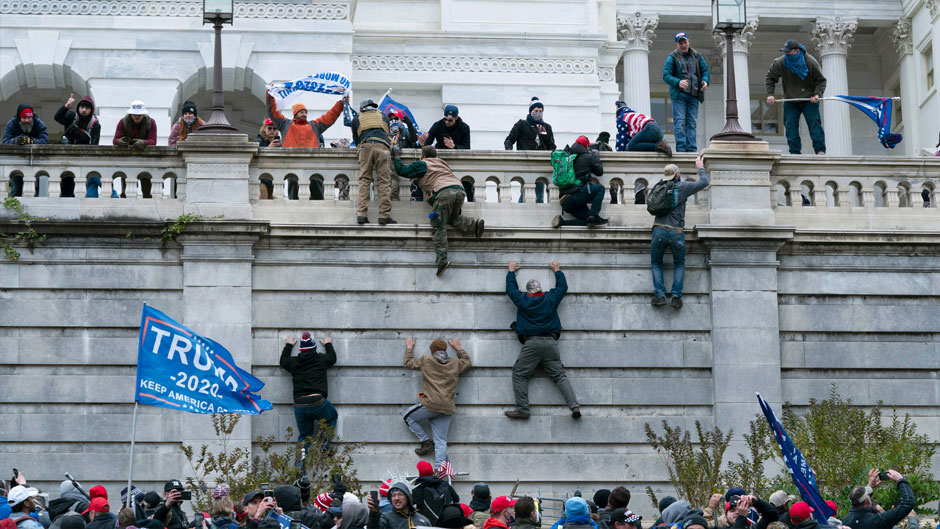A noose hanging outside the United States Capitol. Chants of “Hang Mike Pence.” Members of an angry mob taking and posing for pictures while committing criminal acts.
In some respects, the insurrection at the Capitol building was an all-too-familiar scene, one with striking similarities to the era of lynching in the U.S.
And as was the case during that dark period in U.S. history, the dynamics of the mob mentality was on full display on Jan. 6, as rioters breached the very seat of the nation’s legislative branch, pushing past barricades, clashing with police, and destroying property.
Social scientists and psychologists are already studying what took place at the Capitol building and will, undoubtedly, do so for years to come, offering analyses of why groups of people turn violent and whether humans in mass act as a collective mind.
What is clear is that crowds can be unpredictable, and it is a mixture of selection and causation that make them so, according to Alex R. Piquero, chair of the Department of Sociology in the University of Miami College of Arts and Sciences.
“Some people choose to enter a crowd and or a protest group, and that is what we call selection. There is something about [people] that leads them to do that,” Piquero explained. “But then there is causation—there is something about being in the collective group at the same space and time, and people can be influenced by the crowd, especially when emotions run high among like-minded people. So, there is a bit about people acting of their own volition but also the crowd influencing them.”
People, said Debra Lieberman, associate professor of psychology, “absolutely change their behavior in groups, and we see this across psychology, across different types of social phenomenon.”
Lieberman, whose research aims to understand how evolution has shaped the social mind, referenced the bystander effect, a theory that says people are less inclined to help a victim or intervene in an emergency situation or during a crime when there are others present. “The more people who are onlooking and the more people present, there is a greater diffusion of responsibility. People are less likely to take action,” she said.
“Researchers call it a deindividuation. I am not a fan of that term because each individual is still calculating the risks of action and the likelihood that they’ll get punished for acting or punished for not acting,” Lieberman pointed out. “It’s just part of the calculus—If I’m the only one standing around and I don’t do anything, I’m to blame. If there are two people, I’m only 50 percent to blame. So, people are very sensitive to the chances of them being targeted, punished, and blamed for particular things. This kind of ‘moral psychology’ governs much of what we do.”
Piquero shares his insights on other aspects of crowd behavior and the insurrection at the Capitol.
The civil rights protests of the 1960s were tactical and well organized. Is violence less likely to occur in crowds that have some sort of social structure?
That’s instructive to bring up the civil rights protests, because they were focused on the civil rights of equality for all people, and they were well-organized and typically had one person serving as the leader. What is different with other protests, especially those that are destructive and/or violent, is that there is no consistent messenger delivering the same message to everyone. So, in the latter, there is no leader to gather people together to follow one course of action for a single cause. So, structure helps to guide protests to an extent that they stay focused on a message. And more often than not, those messages are goal-oriented but not violence-infused.
Evidence now shows that some of the people who participated in the Capitol insurrection traveled to Washington, D.C., with the intention to storm the Capitol, planning their actions online. Some individuals, though, must have surely made the trip to D.C. with the intent to protest peacefully.
The issue is simple: the violence that emerged becomes the defining moment of the tragic events in our nation’s capital that led to several deaths, many injuries, and the tarnishing of the people’s house. It was entirely despicable, yet potentially preventable, as there were warnings beforehand that there could have been violence and the response by the federal government—or the lack thereof in terms of preparation and public safety allocation—was to do nothing. What will be remembered from that day, unfortunately, are pictures of a Florida man holding Speaker Pelosi’s lectern, the rebel flag, police officers being assaulted, a woman being shot, and a man sitting in Speaker Pelosi’s chair looking at her email. What won’t be remembered are the protesters who were there to peacefully protest their point of view. For the latter group, they are probably upset that their more positive protest will go unheard and unseen. In a sense then, the peaceful protesters were hijacked by the group who had more nefarious, destructive intentions.
What effect can crowd behavior have on law enforcement officers who are on duty at mass protests/gatherings?
Law enforcement officers have one job, and that is to keep the peace and keep people safe while enforcing the law. In some other ways, they may have conflicting views—as they may agree with the protesters and so have positive sentiments toward them—but still may have to prevent some of their actions. What we saw in Washington, D.C., was that they were overwhelmed, not because they were not trained, but simply because there were not enough of them when there should have been. So, crowd behavior is one thing, but excessive crowds with destructive behavior needs to be met with much more security than what was seen at the Capitol.

